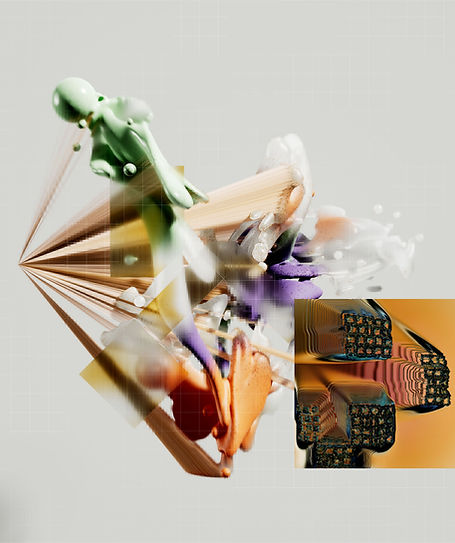Spatial Visualization
If you would like to incorporate activities addressing this competency into your class, please click V-module Competency #5: Spatial Visualization!
Spatial visualization (SV) is a kind of intelligence that translates into an ability to think in three dimensions and to mentally maneuver two- and three-dimensional objects. It is the skill we use when we assemble flat-pack furniture or sew a shirt from a pattern. In this section, basic information is provided on various aspects of SV, including assessment measures, such as the ‘Paper Folding Test.’

A study by Michael et al. (1957) described the SV domain as consisting of three factors: spatial relation and orientation, visualization, and kinesthetic imagery. The study describes the visualization factor as “the ability to comprehend imaginary movements in three-dimensional space or the ability to manipulate objects in the imagination” (p. 188). Spatial visualization includes the ability to imagine the rotation of objects, the folding or unfolding of flat patterns, the relative changes of positions of objects in space, and the motion of machinery. Spatial visualization abilities are relevant to many disciplines in science, including geology and chemistry, as well as art and design.
Tests of SV typically require mental manipulation of visual objects. There are various tests to represent spatial visualization abilities, including: ● Pattern Comprehension test, in which the examinee attempts to match the edges of a solid figure with the corresponding elements portrayed in a plane figure (a pattern drawing). ● Punched Holes test, in which the examinee is given a series of figures representing a square sheet of paper that has been folded step by step (as communicated by dotted lines in adjacent drawings) into smaller squares, rectangles, or triangles and then punched, and is asked to indicate by drawing circles where the holes will be when the sheet of paper is unfolded.
Spatial visualization is used by designers to create and develop new products. Suh and Cho (2020) examined the relationship between creativity and spatial ability with interior design students at a Midwestern US university and found that SV and mental rotation associated with domain-specific spatial ability positively correlated with creativity in interior design projects. Workman et al. (1999) cited studies that link spatial abilities to fashion designing capabilities. For example, individuals who score high on spatial abilities, compared to math and verbal abilities, showed greater participation in hobbies that require creating, shaping, and transforming objects (e.g., sewing and painting).

Compared to math and logical reasoning, spatial abilities tests are the best predictors for success in a garment construction course (Workman et al., 1999). Professionals in product development and apparel design work with two- and three-dimensional visual shape and form, and hence need well-developed spatial abilities, namely spatial relation, spatial orientation, and spatial visualization: ● Spatial relation ability – This involves the ability to discern the arrangement of elements within a visual stimulus pattern. For example, when a dart is rotated to a new position, a patternmaker should be able to imagine the shape of the resulting pattern. ● Spatial orientation ability – This involves the aptitude to remain unconfused by the changing orientation in which a configuration is presented. For example, when draping garments, designers may stand the dress form in front of a mirror to analyze it from a different perspective. ● Spatial visualization ability – This is the ability to mentally manipulate, rotate, twist, or invert pictorially presented visual stimuli. For example, when the designer is required to imagine the back view and side view by looking at the front view of a working sketch, or when the designer needs to imagine the folding or unfolding of flat pattern pieces, or imagine the changes (addition, subtraction) of components of a style like yokes, sleeves, gathers, pockets.

SV skills enable a person to imagine and maneuver objects in 3D. The skill is valuable in STEM careers as well as those in design. In apparel design, SV is related to the imagining of a 3D object as a 2D pattern or vice versa. To measure spatial abilities relative to apparel design and product development, the Apparel Spatial Visualization Test (ASVT) was developed by Workman et al. (1999), which paved the way for various studies on testing and improvement of the spatial visualization competency among apparel design students.
The latest studies have adapted this paper-and-pencil test (ASVT) into the digital environment (Digital ASVT or 3D ASVT) to assess spatial skills geared towards virtual prototyping software, such as Optitex (Orzada et al., 2020) and CLO3D (Mortiz, 2021). With the advent of virtual reality technologies in fashion pedagogy, new ways to enhance and assess SV skills will become increasingly necessary.
References
Michael, W. B., Guilford, J. P., Fruchter, B., & Zimmerman, W. S. (1957). The description of spatial-visualization abilities. Educational and Psychological Measurement, 17(2), 185-199.
Moritz, A. (2021). Spatial ability of transitioning 2d to 3d apparel design: Applying apparel spatial visualization test (asvt) into virtual environment [Doctoral dissertation, University of Missouri—Columbia].
Orzada, S., Ladd, M. E., & Quick, H. H. (2020). A 2kW RF power amplifier for 7T proton imaging with digital pre-distortion. In Proc Intl Soc Mag Reason Med (Vol. 28).
Suh, J., & Cho, J. Y. (2020). Linking spatial ability, spatial strategies, and spatial creativity: A step to clarify the fuzzy relationship between spatial ability and creativity. Thinking Skills and Creativity, 35, 1-17.
Workman, J. E., Caldwell, L. F., & Kallal, M. J. (1999). Development of a test to measure spatial abilities associated with apparel design and product development. Clothing and Textiles Research Journal, 17(3), 128-133.




